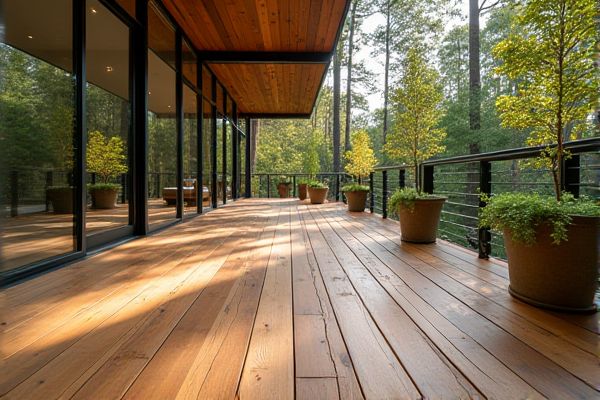
Composite decking offers superior durability and low maintenance compared to natural wood, resisting rot, insects, and fading over time; natural wood provides a classic, authentic appearance with unique grain patterns and the ability to be refinished. Discover which option best suits Your outdoor space needs by exploring the full comparison in the article.
Table of Comparison
| Feature | Composite Decking | Natural Wood |
|---|---|---|
| Material | Wood fibers + plastic | 100% natural timber |
| Durability | High resistance to rot, insects, and weather | Prone to rot, insect damage, and weathering |
| Maintenance | Low; occasional cleaning | High; requires staining, sealing, and regular upkeep |
| Appearance | Consistent color and texture, mimics wood | Natural grain and variation |
| Cost | Higher upfront cost, lower long-term expenses | Lower upfront cost, higher maintenance expenses |
| Environmental Impact | Recycled materials, less deforestation | Requires harvesting trees |
| Installation | Simple, uniform boards | Variable sizes, may require more skill |
| Lifespan | 25-30 years | 15-20 years depending on species and care |
Introduction to Decking Options
Composite decking offers durability and low maintenance with materials made from reclaimed wood fibers and recycled plastics, providing resistance to rot, insects, and fading compared to natural wood. Natural wood decking, such as cedar or redwood, delivers authentic aesthetics and warmth but requires regular upkeep including sealing, staining, and protection against weather damage. Selecting between composite and natural wood decking depends on factors like longevity, environmental impact, appearance preferences, and budget considerations.
Overview of Composite Decking
Composite decking is made from a blend of wood fibers and recycled plastics, offering enhanced durability and low maintenance compared to natural wood. It resists rot, warping, and insect damage while retaining a wood-like appearance with a variety of finishes and colors. Composite decking's eco-friendly composition and longer lifespan make it a popular alternative to traditional hardwood decking for outdoor spaces.
Overview of Natural Wood Decking
Natural wood decking offers a classic, authentic look with rich textures and natural grain patterns, commonly utilizing species like cedar, redwood, and pressure-treated pine. It requires regular maintenance including sealing, staining, and protection from moisture and insects to prevent warping, splintering, and decay. Despite higher upkeep, natural wood decking remains a popular choice for its environmental sustainability and ability to age gracefully with proper care.
Durability and Lifespan Comparison
Composite decking offers superior durability compared to natural wood, resisting rot, splintering, and insect damage due to its engineered materials. While natural wood can last 10 to 30 years depending on species and maintenance, composite decking typically endures 25 to 30 years or more with minimal upkeep. Choosing composite decking ensures your outdoor space maintains its appearance and structural integrity longer, reducing repair and replacement costs.
Maintenance Requirements
Composite decking requires significantly less maintenance than natural wood, as it resists rot, warping, and insect damage without the need for regular sealing or staining. Natural wood demands periodic sanding, staining, and sealing to preserve its appearance and structural integrity, especially in harsh weather conditions. Choosing composite decking can save you time and effort while maintaining a durable and attractive outdoor surface.
Aesthetic Differences
Composite decking offers a uniform appearance with a wide range of colors and textures designed to mimic natural wood, providing consistent beauty without the knots or grain variations found in natural wood. Natural wood showcases unique, authentic grain patterns and color variations that change over time, enhancing its visual appeal through weathering and aging. Your choice depends on whether you prefer the low-maintenance, consistent look of composite materials or the organic, evolving aesthetic of real wood.
Environmental Impact
Composite decking is made from a blend of recycled wood fibers and plastic, reducing deforestation and diverting waste from landfills. Natural wood decking requires the harvesting of trees, which can contribute to deforestation and habitat loss if not responsibly sourced. Choosing composite decking supports sustainability by using recycled materials and offering longer lifespan with less maintenance compared to natural wood.
Cost Analysis: Upfront and Long-Term
Composite decking typically involves higher upfront costs, averaging $30 to $45 per square foot, compared to natural wood's $15 to $25 per square foot. Long-term expenses favor composite decking due to its low maintenance, resistance to rot, warping, and insects, significantly reducing repair and replacement costs over a lifespan of 25-30 years. Natural wood demands regular sealing and staining, contributing to ongoing maintenance costs that often surpass the initial savings within 10 years.
Installation Process and Time
Composite decking typically offers a faster and more straightforward installation process compared to natural wood, as its uniform boards are pre-manufactured with consistent dimensions and built-in fastening systems. Natural wood requires more preparation, such as cutting, sanding, and sealing, which can extend the overall installation time significantly. Choosing composite decking can save you time and effort, especially if you prefer a hassle-free setup with minimal maintenance.
Conclusion: Choosing the Right Decking Material
Composite decking offers enhanced durability, low maintenance, and resistance to weather, insects, and rot, making it ideal for long-term investment. Natural wood provides classic beauty, a unique grain pattern, and a warm aesthetic that can increase your home's charm but requires regular upkeep and sealing. Your choice depends on balancing ease of maintenance with the desired look and budget for your outdoor space.
 homyna.com
homyna.com